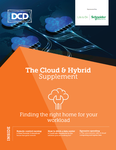Modern enterprises need to manage complex collections of services and workloads that increasingly span multiple clouds and edge locations. This changing dynamic is affecting where and how our cloud workloads are deployed, and the number of cloud offerings to consider.
The multi-cloud approach is nothing new – 87 percent of European enterprises are using multiple public cloud platforms (Forrester) and businesses have been moving workloads to cloud hyperscalers for more than a decade. More recently, more efficient options have emerged offering lower costs, more agility, and greater simplicity to accommodate new workloads and complement existing ones.
While it can seem overwhelming to navigate the various cloud offerings to find the best mix to serve your business’ needs, the pay-off can be exponential. Instead of arbitrarily deploying workloads to any available cloud, consider your workloads and what they need to run most effectively.
Here we will explain what to consider when it comes to configuring your multi-cloud set up including the features that are best suited to serve particular workloads – putting yours and your customers’ needs at the forefront.
Developer-friendly simplicity and ease-of-use
Enterprises are discovering that the developer experience – and developer productivity – is pivotal to business success in the cloud alongside core elements like performance, security, cost, service, and global footprint.
Developers are the engine room of the modern digital economy. They want ease of use, simplicity, and programmability from the platforms where they deploy apps. We know that developers don’t want any obstacles that can hinder their ability to ship code and developer support is a huge factor to consider when cloud shopping.
A developer-friendly offering should include open toolkits, APIs, easily integrated PaaS, pre-integrated third party addons, and responsive, certified, and knowledgeable technical support. This ease of use allows for flexibility and enables your DevOps team to seamlessly conduct application load testing and run basic containerized workloads uninterrupted.
Cost transparency and flexibility
With increasing economic pressures and an uncertain forecast looking ahead to 2023, businesses of all sizes are looking to save costs wherever possible. Worldwide end-user spending on public cloud services is forecast to grow 20.4 percent this year, totalling $494.7bn, and this figure is expected to reach nearly $600bn in 2023 (Gartner). This means it’s important to make your chosen platforms work smarter, not harder, and using one sole cloud provider does not tend to be the most cost effective. Taking a multi-cloud approach enables you to select the best solutions for each workload, giving developers and architects the flexibility they need, and avoiding high costs on services that aren’t best suited to your workloads.
Cloud offerings to look out for when shopping for workloads like this are those that offer predictable pricing, easy-to-use developer-friendly environments – allowing them to be simply up- and down-scaled on demand – and global Points of Presence (PoPs).
Workloads that can easily accrue high costs due to high egress are those requiring high performance pressure, low latency and egress intensity, such as gaming and video streaming. Using a cloud platform that is tied to a CDN can ease some of this pressure and enable efficient scaling around peak times.
Likewise, some workloads don’t require an always-on cloud platform, meaning they are best suited to an offering that can be turned on and off whenever – and wherever – it is needed, without usage commitments or complicated pricing. Workloads that are suited to greater flexibility include those requiring portability and/or periodic usage patterns such as load testing, data processing, transcoding, and disaster recovery, as well as workloads that need to be deployed in specific geographies.
Performance
Ensuring your cloud computing environment works effectively whenever and wherever you need it is crucial. Performance can make or break customer perceptions and have a direct impact on your business’ bottom line.
Some workloads that are particularly sensitive when it comes to performance are data processing, real-time communication, live score updates, video streaming, and API distribution. These workloads often have immediate impact, and consumers are unwilling to tolerate lags or long wait times.
When cloud shopping for a workload that is performance intensive, be sure to look for cloud providers that offer inter-connectivity, optimized Internet routing, global PoPs, and low latency.
Scale and security
Cloud platforms must have global reach, significant outbound network capacity, and high data security capabilities to keep up with the rapid growth in scale and complexity of enterprise applications and workloads. In a global economy, enterprises need to be able to instantly scale applications to respond to demand and geographies with local compute and storage resources. The ability to distribute workloads to the edge is also crucial - bringing the data closer to applications’ ultimate consumers.
As cybersecurity threats continue to plague all businesses and cyber-criminals target weaknesses within the cloud to exploit. All enterprise applications – such as HR, payroll, and email systems – as well as backups and any tools that facilitate internal collaboration and wide-spread human interaction are at risk when it comes to cybersecurity and potential breaches.
A cloud platform using a Zero Trust architecture ensures that users are only given the access they need to fulfil specific tasks and can mitigate the widespread impact cyberthreats can have within an organization. It manages access control and segmentation, DDoS protection, and application security, reducing the level of potential risk by reducing the number of people who have access to sensitive data. Choosing a highly secure cloud provider to manage your most sensitive workloads makes good business sense and can form part of a diverse and fit-for-purpose multi-cloud mix.
By taking a workload-first approach, there is no need to retrofit your business needs to what one or two cloud providers are able to offer. This approach enables you to put your commercial and customer priorities first, and benefit from a breadth of providers that serve as many different purposes as you have workloads - without the need to worry about complex processes or high costs. When it comes to the cloud, more is more.





